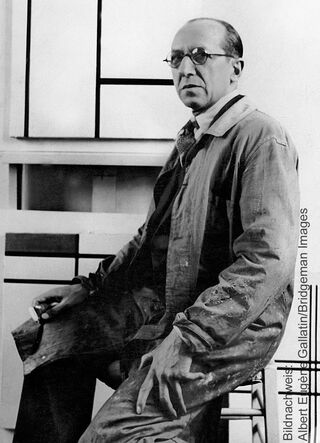Picture "Composition No. II, with Red and Blue" (1929), framed


Picture "Composition No. II, with Red and Blue" (1929), framed
Quick info
ars mundi Exclusive Edition | limited, 499 copies | numbered | certificate | reproduction, Giclée print on canvas | on stretcher frame | framed | size approx. 60 x 49 cm (h/w)
Detailed description
Picture "Composition No. II, with Red and Blue" (1929), framed
Original: 1929, oil on canvas, 40.5 x 32 cm, Museum: New York, Museum of Modern Art.
Edition transferred directly onto artist's canvas using the Fine Art Giclée process and stretched on a stretcher frame. Limited edition of 499 copies, numbered, with certificate. Framed in handmade, black and silver-coloured solid wood frame. Size approx. 60 x 49 cm (h/w). ars mundi Exclusive Edition.

About Piet Mondrian
1872-1944
It is hard to imagine that Piet Mondrian's strictly geometric compositions had their origins in painterly, filigree landscape studies. At the age of 20, as a student of the Art Academy in Amsterdam, he was drawn to Impressionism. In the neutral Netherlands, he was spared the turmoil of the First World War for a long time and was able to follow his inspiration and theosophical studies. There the first Fauvist and Neo-Impressionist elements appeared in his paintings.
In Paris, which he visited for the first time in 1912, he took part in several "Salons des Indépendants", where he was influenced by the cubism of Georges Braque and Pablo Picasso. Mondrian for example reduced the lines of a tree until the form of the tree is barely discernable and black, orthogonal bars divided the picture surface and becomes secondary to the overall composition of vertical and horizontal lines, he filled the spaces in between with white and primary colours.
Because of his profound knowledge of abstraction, he co-founded the painter, designer and architect group "De Stijl" in 1917 - the Dutch counterpart to the German group "Bauhaus". In his paintings, everything should be in balance, the depth effect should disappear so that "pure reality" remains.
Mondrian's visionary style left clear traces in art, design and architecture, also in New York, where the artist finally emigrated in 1940.
Term for paintings and sculptures that are detached from the representational depiction, which spread throughout the entire western and parts of the eastern world from around 1910 onwards in ever new stylistic variations. The Russian painter Wassily Kandinsky, born in 1866, is considered the founder of abstract art. Other important artists of abstract art are K.S. Malewitsch, Piet Mondrian, and others.
Graphic or sculpture edition that was initiated by ars mundi and is available only at ars mundi or at distribution partners licensed by ars mundi.
Giclée = derived from the French verb gicler "to squirt, spurt".
The giclée method is a digital printing process. It is a high-resolution, large-format printout on an inkjet printer with special different-coloured dye- or pigment-based inks (usually six to twelve). The colours are fade-proof, i.e. resistant to harmful UV light. They have a high richness of nuance, contrast and saturation.
The giclée process is suitable for art canvases, handmade and watercolour paper as well as for silk.






